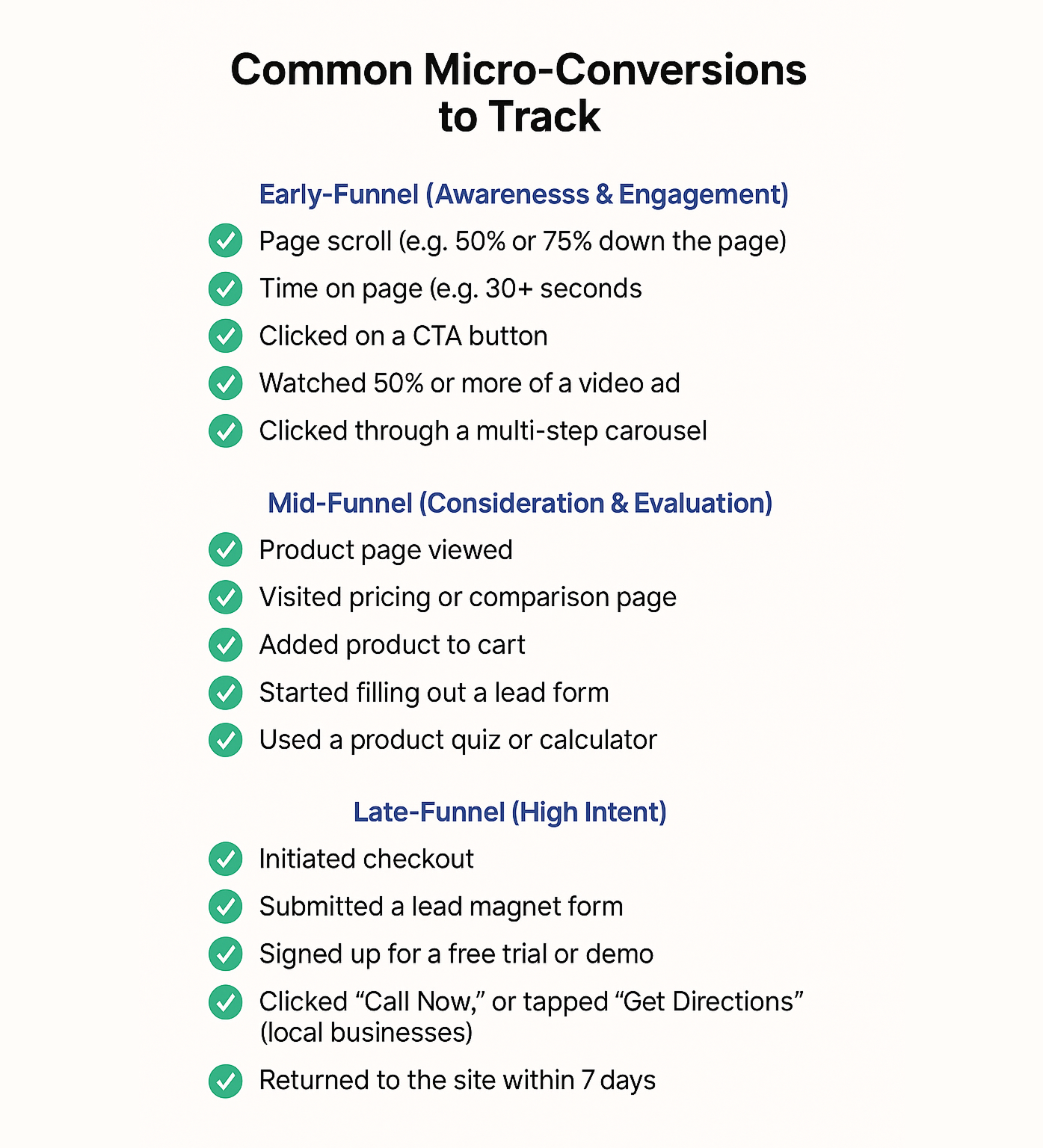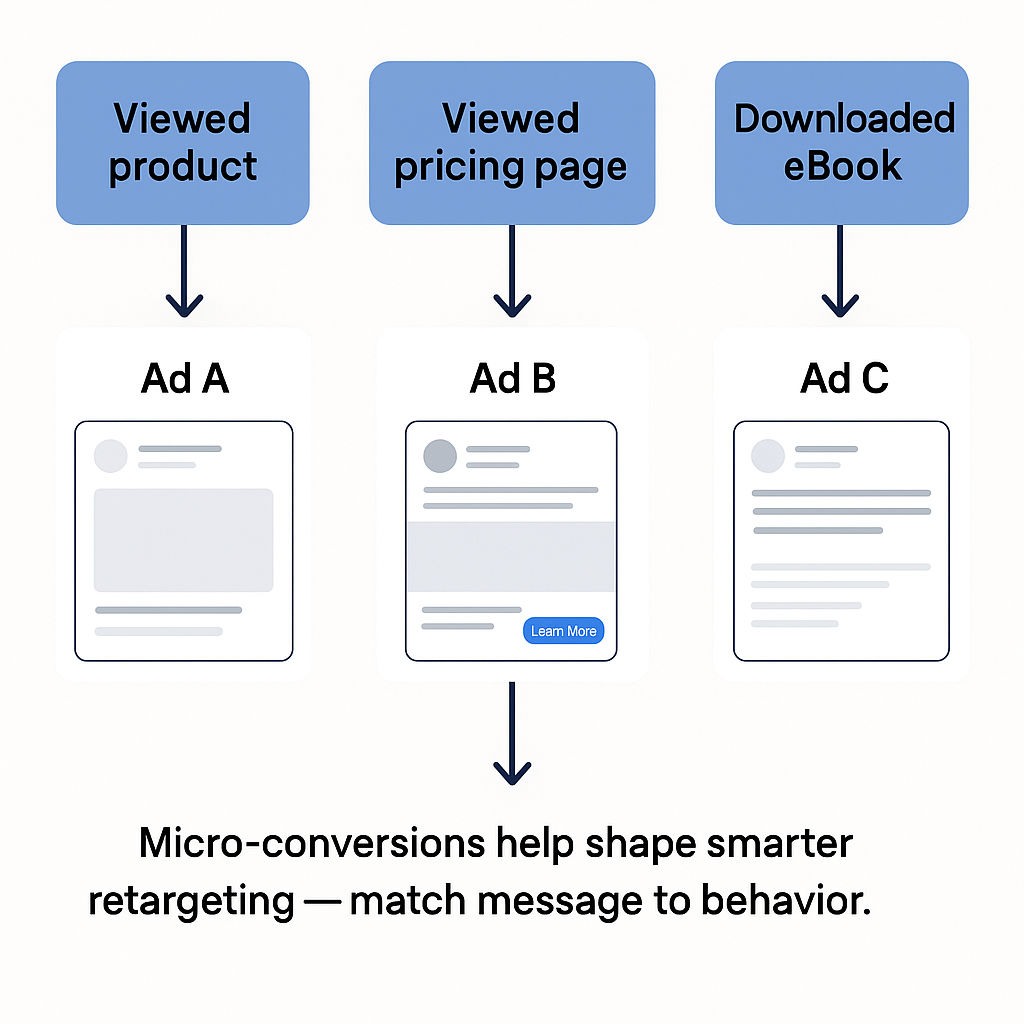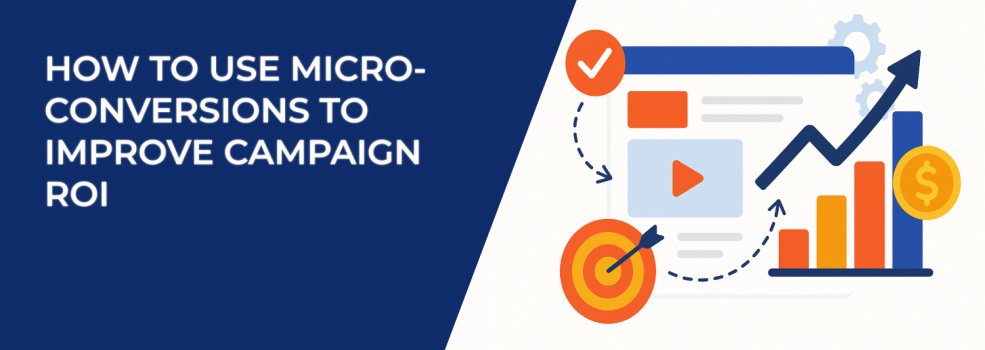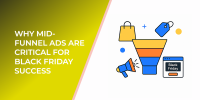Running paid ad campaigns is a game of attention, timing, and data. Whether you're a marketer in New York, an eCommerce store in London, or an agency in Sydney, one thing is true across the board: if you’re only watching final conversions, you’re missing 80% of the story.
Let’s dig into micro-conversions — the small, often-overlooked actions that can lead to a big lift in ROI for your Facebook, Instagram, and Google ad campaigns.
What Are Micro-Conversions?
Micro-conversions are the small steps users take along the path to your end goal — like buying a product, booking a consultation, or signing up for a service. Unlike primary conversions, these actions don’t make you money right away. But they signal user intent and provide critical behavioral data that help you optimize earlier in the journey.

They’re like the tracks in the snow — they tell you where people are going, even before they get to the final destination.
Some examples of high-signal micro-conversions include:
-
Viewing a product or pricing page
This suggests the user is actively evaluating your offer. They're not just browsing; they're exploring. -
Clicking on a CTA button
A click on “Buy Now,” “Get a Quote,” or “Learn More” is a clear sign of engagement — and often signals the beginning of deeper funnel movement. -
Adding a product to cart
This is one of the most common and important micro-conversions in eCommerce. It’s often where intent meets hesitation. -
Starting to fill out a lead form
Tracking form field entries (even if not submitted) shows strong buying or inquiry intent. You can even create retargeting audiences from form abandonment. -
Engaging with an ad
Metrics like watching 50%+ of a video, clicking through a carousel, or engaging with an Instagram Story are all micro-actions that show content resonance. -
Signing up for your newsletter or free trial
These actions offer access to long-term nurture flows and can signal high interest in your brand — especially in the B2B and SaaS world. -
Downloading gated content
When someone grabs your checklist, eBook, or guide, they’re showing interest in solving a specific problem — and that’s a hot lead if you nurture them well.
Pro Tip: Local businesses running Meta ads in places like Los Angeles or London should track location-specific actions, like clicking on map directions, checking store hours, or clicking to call. These are perfect micro-conversions in a foot-traffic funnel.
Why Do Micro-Conversions Matter for ROI?
If you're only tracking sales or lead completions, you're relying on a tiny sliver of data. Micro-conversions offer a more complete picture of your funnel — especially valuable when conversion volume is low or when you’re testing new campaigns.
Here’s what they can help you uncover:
-
Where users drop off in your funnel
By identifying the last action a user took, you can spot friction or confusion that prevents them from converting. -
What users care about
You’ll discover which pages, products, or content pieces capture real attention. -
How well your ads guide behavior
If people are clicking but not taking next steps, your offer or UX may need refinement.
Tracking micro-conversions becomes especially critical when you’re struggling with performance or working with lower budgets. In those cases, your campaign might not generate enough final conversions for the algorithm to learn efficiently — that’s where optimizing for events like "Add to Cart" or "Lead Form Start" can bridge the data gap.
If you're facing poor performance, this guide can help you fix Facebook ads that aren't converting.
How to Track Micro-Conversions Correctly
You can’t optimize what you don’t measure — and you shouldn’t measure what doesn’t matter. That’s why tracking the right micro-conversions, with precision, is the key.
Step 1: Define Micro-Conversions That Fit Your Funnel
Not every action is created equal. A scroll or a bounce doesn't tell you much. Instead, focus on clear intent signals that move users closer to the goal.
Here are tailored examples based on business type:
-
Ecommerce: Add to cart, product view 2+ times, started checkout.
-
SaaS: Free trial sign-up, pricing page viewed, demo request started.
-
Local services: Click to call, map click, “Get a Quote” form start.
These help segment user behavior based on their level of interest — so you can tailor your next steps accordingly.
Step 2: Set Up Tracking with Proper Tools
You’ll need a robust setup to track micro-events. This includes:
-
Google Tag Manager — to fire events like scrolls, button clicks, and video watches.
-
Meta Events Manager — to set up custom conversions and standard events for Meta Ads.
-
GA4 (Google Analytics) — for funnel reports and cross-platform data.
-
Tools like Hotjar or Microsoft Clarity — to analyze session behavior and drop-off points visually.
It’s also crucial to implement your Meta Pixel correctly, with the right events assigned. If you’re unsure, use this setup guide for Facebook Pixel optimization.
Step 3: Align Events with Campaign Optimization
Don’t just track micro-conversions — use them as active goals in your campaigns. For instance:
-
Optimize new campaigns for “Add to Cart” or “Lead Form Start” before switching to final conversions.
-
Create custom audiences based on these events for warm retargeting.
-
Use conversion value estimates for high-intent events to help Meta’s algorithm improve decision-making.
And if your campaign is stuck in the learning phase? Learn how to exit faster by feeding smarter data.
How to Optimize Campaigns Using Micro-Conversions
Once you’ve got micro-conversions dialed in, here’s how to use them to squeeze more ROI out of every campaign.
1. Choose Objectives That Match Your Volume
When you don’t have enough final conversions (especially in B2B, high-ticket, or niche markets), Facebook’s algorithm can’t learn effectively. That’s why it’s better to optimize for mid-funnel actions first.
Common examples:
-
A store in Toronto may start optimizing for “Add to Cart” during low season.
-
A US-based financial consultant might choose “Form Step 1” while launching new lead gen ads.
This strategy helps avoid under-delivery — including the notorious “Ad Set May Get Zero” message.
2. Segment and Retarget Based on Micro-Actions
Not all visitors are created equal. Instead of lumping everyone together, split them by behavior. This allows you to write more relevant copy and deliver the right message at the right time.

Try segments like:
-
Users who added to cart but didn’t purchase — offer a time-limited discount.
-
Visitors who viewed your pricing page — retarget with testimonials or FAQs.
-
Readers who downloaded your guide — upsell with a webinar invite.
This behavior-first targeting is foundational in advanced campaigns. Want to go deeper? Here’s how top e-commerce brands use behavior-based Facebook targeting.
3. Use Micro-Conversion Data to Improve Funnels
If you’re seeing good micro-conversion volume — but final conversion rates are flat — your funnel may be broken.
Common issues include:
-
A mobile checkout page that’s too slow.
-
Too many required form fields.
-
Surprise shipping costs or unclear return policies.
Use session replay tools, analytics funnels, and heatmaps to identify problem spots. Want a full-funnel strategy to connect the dots? Here’s how to analyze Facebook ad performance beyond CTR and CPC.
Avoiding Vanity Metrics: Which Micro-Conversions Actually Matter?
Some actions look good on reports but don’t actually indicate buying intent. Be selective about which events you treat as meaningful.
Low-value (vanity) micro-conversions you should be careful with:
-
Page views,
-
Scroll depth,
-
Likes or shares (unless tied to a strong offer).
Instead, prioritize high-value micro-conversions, such as:
-
Initiated checkout,
-
Lead form started,
-
Product customized,
-
Price or feature comparison clicked.
These micro-actions are more tightly tied to real buyer behavior. They’re also better training signals for machine learning on platforms like Meta.
Final Takeaway: Track the Journey, Not Just the Destination
Micro-conversions aren’t just “nice to have” — they’re critical indicators of funnel health, customer interest, and campaign alignment.
They help you:
-
Optimize faster,
-
Spend smarter,
-
Retarget better,
-
Improve user experience,
-
Drive higher ROI — even if your budget is limited.
Whether you’re managing Meta Ads in the UK, testing Google Ads in Canada, or scaling Shopify campaigns in Australia — micro-conversion tracking is your next performance advantage.

